Assessing the Wall-to-Wall Spatial and Qualitative Dynamics of the Brazilian Pasturelands 2010–2018, Based on the Analysis of the Landsat Data Archive
Abstract
:1. Introduction
2. Materials and Methods
2.1. Pasture Quality Classification
2.2. Pre-Processing
2.3. Pasture Degradation Classes
2.4. Pasture Degradation Index by Property (PDI)
2.5. Evaluation of Pasture Recovery Efficiency through ABC Plan Resources
2.6. Accuracy Analysis
3. Results
3.1. Spatiotemporal Dynamics of Pasture Quality in Brazil
3.2. Factors Related to Variation in Pasture Quality by Rural Property
4. Discussion
4.1. Spatial and Quality Dynamics of Pastures in Brazil
4.2. Relationship between the Size of the Rural Property and the Contribution of Resources from the ABC Plan with the Quality of Pastures
5. Conclusions
Supplementary Materials
Author Contributions
Funding
Informed Consent Statement
Data Availability Statement
Acknowledgments
Conflicts of Interest
References
- ABIEC. Perfil da Pecuária no Brasil; Associação Brasileira das Indústrias Exportadoras de Carnes: Lima, Brazil, 2020. [Google Scholar]
- IBGE. Pesquisa Pecuária Municipal. 2020. Available online: Sidra.ibge.gov.br/pesquisa/ppm/quadros/brasil/2019 (accessed on 19 December 2020).
- USDA. Livestock and Products Annual, Brazil 2020; USDA: Washington, DC, USA, 2020; p. 17. [Google Scholar]
- Dias Filho, M.B. Degradação de Pastagens: Processos, Causas e Estratégias de Recuperação. MBDF 2011, 4, 204. [Google Scholar]
- Parente, L.; Mesquita, V.; Miziara, F.; Baumann, L.; Ferreira, L. Assessing the pasturelands and livestock dynamics in Brazil, from 1985 to 2017: A novel approach based on high spatial resolution imagery and Google Earth Engine cloud computing. Remote Sens. Environ. 2019, 232, 111301. [Google Scholar] [CrossRef]
- Vieira-Filho, J.E.R.; Fishlow, A. Agricultura e Indústria no Brasil: Inovação e Competitividade; Columbia University Press: New York, NY, USA, 2017; p. 305. [Google Scholar]
- Parente, L.; Ferreira, L. Assessing the spatial and occupation dynamics of the Brazilian pasturelands based on the automated classification of MODIS images from 2000 to 2016. Remote Sens. 2018, 10, 606. [Google Scholar] [CrossRef] [Green Version]
- Zalles, V.; Hansen, M.C.; Potapov, P.V.; Parker, D.; Stehman, S.V.; Pickens, A.H.; Parente, L.L.; Ferreira, L.G.; Song, X.; Hernandez-Serna, A.; et al. Rapid expansion of human impact on natural land in South America since 1985. Sci. Adv. 2021, 7, eabg1620. [Google Scholar] [CrossRef] [PubMed]
- Barona, E.; Ramankutty, N.; Hyman, G.; Coomes, O.T. The role of pasture and soybean in deforestation of the Brazilian Amazon. Environ. Res. Lett. 2010, 5, 024002. [Google Scholar] [CrossRef]
- Cardille, J.A.; Foley, J.A. Agricultural land-use change in Brazilian Amazônia between 1980 and 1995: Evidence from integrated satellite and census data. Remote Sens. Environ. 2003, 87, 551–562. [Google Scholar] [CrossRef]
- Stabile, M.C.C.; Guimarães, A.L.; Silva, D.S.; Ribeiro, V.; Macedo, M.N.; Coe, M.T.; Pinto, E.; Moutinho, P.; Alencar, A. Solving Brazil’s land use puzzle: Increasing production and slowing Amazon deforestation. Land Use Policy 2020, 91, 104362. [Google Scholar] [CrossRef]
- Oliveira, O.C.; Oliveira, I.P.; Alves, B.J.R.; Urquiaga, S.; Boddey, R.M. Chemical and biological indicators of decline/degradation of Brachiaria pastures in the Brazilian Cerrado. Agric. Ecosyst. Environ. 2004, 103, 289–300. [Google Scholar] [CrossRef]
- Volpe, E.; Marchetti, M.E.; Macedo, M.C.M.; Rosa, E.J. Renovação de pastagem degradada com calagem, adubação e leguminosa consorciada em neossolo Quartzarênico. Acta Sci. Agron. 2008, 30, 131–138. [Google Scholar] [CrossRef]
- Dias Filho, M.B. Diagnóstico das Pastagens no Brasil; Empresa Brasileira de Pesquisa Agropecuária: Brasilia, Brazil, 2014; p. 36. [Google Scholar]
- Lahsen, M.; Bustamante, M.M.C.; Dalla-Nora, E.L. Undervaluing and Overexploiting the Brazilian Cerrado at Our Peril. Environ. Sci. Policy Sustain. Dev. 2016, 58, 4–15. [Google Scholar] [CrossRef] [Green Version]
- Braz, S.P.; Urquiaga, S.; Alves, B.J.R.; Jantalia, C.P.; Guimarães, A.P.; dos Santos, C.A.; dos Santos, S.C.; Machado Pinheiro, É.F.; Boddey, R.M. Soil Carbon Stocks under Productive and Brachiaria Degraded Pastures in the Brazilian Cerrado. Soil Sci. Soc. Am. 2013, 77, 914–928. [Google Scholar] [CrossRef]
- Bustamante, M.M.C.; Nobre, C.A.; Smeraldi, R.; Aguiar, A.P.D.; Barioni, L.G.; Ferreira, L.G.; Longo, K.; May, P.; Pinto, A.S.; Ometto, J.P.H.B. Estimating greenhouse gas emissions from cattle raising in Brazil. Clim. Change 2012, 115, 559–577. [Google Scholar] [CrossRef]
- FAO. Five Practical Actions Towards Low-Carbon Livestock; FAO: Rome, Italy, 2019. [Google Scholar]
- Pereira, L.F.; Ferreira, C.F.C.; Guimarães, R.M.F. Manejo, Qualidade E Dinâmica Da Degradação De Pastagens Na Mata Atlântica De Minas Gerais—Brasil. Nativa 2018, 6, 370. [Google Scholar] [CrossRef]
- West, P.C.; Gerber, J.S.; Engstrom, P.M.; Mueller, N.D.; Brauman, K.A.; Carlson, K.M.; Cassidy, E.S.; Johnston, M.; MacDonald, G.K.; Ray, D.K.; et al. Leverage points for improving global food security and the environment. Science 2014, 80, 325–328. [Google Scholar] [CrossRef] [PubMed] [Green Version]
- Alves-Pinto, H.N.; Newton, P.; Guedes Pinto, L.F. Reducing deforestation and enhancing sustainability in commodity supply chains: Interactions between governance interventions and cattle certification in Brazil. Trop. Conserv. Sci. 2015, 8, 1053–1079. [Google Scholar] [CrossRef] [Green Version]
- Embrapa. GeoDegrade. 2012. Available online: www.geodegrade.cnpm.embrapa.br/apresentacao (accessed on 10 January 2021).
- ICV. Programa Novo Campo. 2021. Available online: www.icv.org.br/projeto_especial/programa-novo-campo/ (accessed on 10 January 2021).
- MAPA. Plano Setorial de Mitigação e Adaptação às Mudanças Climáticas para Consolidação da Economia de Baixa Emissão de Carbono na Agricultura—PLANO ABC. Rev. Bras. De Geogr. Física 2012, 4, 1266–1274. [Google Scholar]
- Latawiec, A.E.; Strassburg, B.B.N.; Valentim, J.F.; Ramos, F.; Alves-Pinto, H.N. Intensification of cattle ranching production systems: Socioeconomic and environmental synergies and risks in Brazil. Animal 2014, 8, 1255–1263. [Google Scholar] [CrossRef] [Green Version]
- Souza, C.M.; Shimbo, J.Z.; Rosa, M.R.; Parente, L.L.; Alencar, A.A.; Rudorff, B.F.T.; Hasenack, H.; Matsumoto, M.; Ferreira, L.G.; Souza-Filho, P.W.M.; et al. Reconstructing three decades of land use and land cover changes in brazilian biomes with landsat archive and earth engine. Remote Sens. 2020, 12, 2735. [Google Scholar] [CrossRef]
- Gao, Q.; Li, Y.; Wan, Y.; Lin, E.; Xiong, W.; Jiangcun, W.; Wang, B.; Li, W. Grassland degradation in Northern Tibet based on remote sensing data. J. Geogr. Sci. 2006, 16, 165–173. [Google Scholar] [CrossRef]
- Olexa, E.M.; Lawrence, R.L. Performance and effects of land cover type on synthetic surface reflectance data and NDVI estimates for assessment and monitoring of semi-arid rangeland. Int. J. Appl. Earth Obs. Geoinf. 2014, 30, 30–41. [Google Scholar] [CrossRef]
- Reinermann, S.; Asam, S.; Kuenzer, C. Remote sensing of grassland production and management—A review. Remote Sens. 2020, 12, 1949. [Google Scholar] [CrossRef]
- Aguiar, D.A.; Mello, M.P.; Nogueira, S.F.; Gonçalves, F.G.; Adami, M.; Rudorff, B.F.T. MODIS Time Series to Detect Anthropogenic Interventions and Degradation Processes in Tropical Pasture. Remote Sens. 2017, 9, 73. [Google Scholar] [CrossRef] [Green Version]
- Arantes, A.E.; Couto, V.R.M.; Sano, E.E.; Ferreira, L.G. Livestock intensification potential in Brazil based on agricultural census and satellite data analysis. Pesqui. Agropecuária Bras. 2018, 53, 1053–1060. [Google Scholar] [CrossRef] [Green Version]
- Pereira, O.J.R.; Ferreira, L.G.; Pinto, F.; Baumgarten, L. Assessing pasture degradation in the Brazilian Cerrado based on the analysis of MODIS NDVI time-series. Remote Sens. 2018, 10, 1761. [Google Scholar] [CrossRef] [Green Version]
- Brito, J.L.S.; Arantes, A.E.; Ferreira, L.G.; Sano, E.E. MODIS estimates of pasture productivity in the Cerrado based on ground and Landsat-8 data extrapolations. J. Appl. Remote Sens. 2018, 12, 1. [Google Scholar] [CrossRef]
- Chen, Y.; Guerschman, J.; Shendryk, Y.; Henry, D.; Harrison, M.T. Estimating Pasture Biomass Using Sentinel-2 Imagery and Machine Learning. Remote Sens. 2021, 13, 603. [Google Scholar] [CrossRef]
- Dos Reis, A.A.; Werner, J.P.S.; Silva, B.C.; Figueiredo, G.K.D.A.; Antunes, J.F.G.; Esquerdo, J.C.D.M.; Coutinho, A.C.; Lamparelli, R.A.C.; Rocha, J.V.; Magalhães, P.S.G. Monitoring Pasture Aboveground Biomass and Canopy Height in an Integrated Crop–Livestock System Using Textural Information from PlanetScope Imagery. Remote Sens. 2020, 12, 2534. [Google Scholar] [CrossRef]
- Arantes, A.E.; Ferreira, L.G.; Coe, M.T. The seasonal carbon and water balances of the Cerrado environment of Brazil: Past, present, and future influences of land cover and land use. ISPRS J. Photogramm. Remote Sens. 2016, 117, 66–78. [Google Scholar] [CrossRef]
- Andrade, R.G.; Aparecida, C.; Rodrigues, G.; Del, I.; Sanches, A.; Enrique, F.; Quartaroli, C.F. Uso de técnicas de sensoriamento remoto na detecção de processos de degradação de pastagens. Eng. Agric. 2013, 21, 234–243. [Google Scholar]
- LAPIG. Atlas Digital das Pastagens Brasileiras. 2020. Available online: http://atlasdaspastagens.ufg.br/ (accessed on 19 December 2020).
- Gosch, M.S.; Parente, L.L.; Ferreira, N.C.; Oliveira, A.R.O.; Ferreira, L.G. Pastagens degradadas, uma herança dos imóveis rurais desapropriados para os assentamentos rurais do Cerrado goiano. Rev. Campo Territ. 2020, 15, 202–229. [Google Scholar] [CrossRef]
- Rouse, W.; Haas, R.H.; Deering, D.W. Monitoring Vegetation Systems in the Great Plains with ERTS, NASA SP-351; NASA: Washington, DC, USA, 1973; Volume 1. [Google Scholar]
- Eckert, S.; Hüsler, F.; Liniger, H.; Hodel, E. Trend analysis of MODIS NDVI time series for detecting land degradation and regeneration in Mongolia. J. Arid Environ. 2015, 113, 16–28. [Google Scholar] [CrossRef]
- Gargiulo, J.; Clark, C.; Lyons, N.; de Veyrac, G.; Beale, P.; Garcia, S. Spatial and temporal pasture biomass estimation integrating electronic plate meter, planet cubesats and sentinel-2 satellite data. Remote Sens. 2020, 12, 3222. [Google Scholar] [CrossRef]
- Olofsson, P.; Foody, G.M.; Herold, M.; Stehman, S.V.; Woodcock, C.E.; Wulder, M.A. Good practices for estimating area and assessing accuracy of land change. Remote Sens. Environ. 2014, 148, 42–57. [Google Scholar] [CrossRef]
- Gorelick, N.; Hancher, M.; Dixon, M.; Ilyushchenko, S.; Thau, D.; Moore, R. Google Earth Engine: Planetary-scale geospatial analysis for everyone. Remote Sens. Environ. 2017, 202, 18–27. [Google Scholar] [CrossRef]
- Davidson, E.A.; de Araújo, A.C.; Artaxo, P.; Balch, J.K.; Brown, I.F.; Bustamante, M.M.C.; Coe, M.T.; DeFries, R.S.; Keller, M.; Longo, M.; et al. The Amazon basin in transition. Nature 2012, 481, 321–328. [Google Scholar] [CrossRef]
- Sparovek, G.; Reydon, B.P.; Guedes Pinto, L.F.; Faria, V.; de Freitas, F.L.M.; Azevedo-Ramos, C.; Gardner, T.; Hamamura, C.; Rajão, R.; Cerignoni, F.; et al. Who owns Brazilian lands? Land Use Policy 2019, 87, 104062. [Google Scholar] [CrossRef]
- Parente, L.; Nogueira, S.; Baumann, L.; Almeida, C.; Maurano, L.; Affonso, A.G.; Ferreira, L. Quality assessment of the PRODES Cerrado deforestation data. Remote Sens. Appl. Soc. Environ. 2021, 21, 100444. [Google Scholar] [CrossRef]
- Oliveira, E.R.; Couto, V.R.M. Productive and Economic Viability of Raising Beef Cattle in the Savanna of the Brazilian State of Goiás. Rev. Econ. Sociol. Rural 2018, 56, 395–410. [Google Scholar] [CrossRef] [Green Version]
- Martha-Júnior, G.B.; Vilela, L. Pastagens no Cerrado: Baixa Produtividade pelo Pastagens no Cerrado; Empresa Brasileira de Pesquisa Agropecuária: Brasilia, Brazil, 2002; p. 30. [Google Scholar]
- Garrett, R.D.; Koh, I.; Lambin, E.F.; le Polain de Waroux, Y.; Kastens, J.H.; Brown, J.C. Intensification in agriculture-forest frontiers: Land use responses to development and conservation policies in Brazil. Glob. Environ. Chang. 2018, 53, 233–243. [Google Scholar] [CrossRef]
- Alencar, A.; Pereira, C.; Castro, I.; Cardoso, A.; Souza, L.; Costa, R.; Bentes, A.J.; Stella, O.; Azevedo, A.; Gomes, J.; et al. Desmatamento nos Assentamentos da Amazônia: Histórico, Tendências e Oportunidades; IPAM: Brasilia, Brazil, 2016; p. 93. [Google Scholar]
- Castro, C.N.; Pereira, C.N. Agricultura familiar, assistência técnica e extensão rural e a política nacional de Ater. Inst. Pesqui. Econômica Apl. 2017, 1, 48. [Google Scholar]
- Nepstad, D.; McGrath, D.; Stickler, C.; Alencar, A.; Azevedo, A.; Swette, B.; Bezerra, T.; DiGiano, M.; Shimada, J.; Motta, R.S.; et al. Slowing Amazon deforestation through public policy and interventions in beef and soy supply chains. Science 2014, 344, 1118–1123. [Google Scholar] [CrossRef] [PubMed]
- Latawiec, A.E.; Strassburg, B.B.N.; Silva, D.; Alves-Pinto, H.N.; Feltran-Barbieri, R.; Castro, A.; Iribarrem, A.; Rangel, M.C.; Kalif, K.A.B.; Gardner, T.; et al. Improving land management in Brazil: A perspective from producers. Agric. Ecosyst. Environ. 2017, 240, 276–286. [Google Scholar] [CrossRef]
- Strassburg, B.B.N.; Latawiec, A.E.; Barioni, L.G.; Nobre, C.A.; Silva, V.P.; Valentim, J.F.; Vianna, M.; Assad, E.D. When enough should be enough: Improving the use of current agricultural lands could meet production demands and spare natural habitats in Brazil. Glob. Environ. Chang. 2014, 28, 84–97. [Google Scholar] [CrossRef] [Green Version]
- Lambin, E.F.; Gibbs, H.K.; Ferreira, L.; Grau, R.; Mayaux, P.; Meyfroidt, P.; Morton, D.C.; Rudel, T.K.; Gasparri, I.; Munger, J. Estimating the world’s potentially available cropland using a bottom-up approach. Glob. Environ. Chang. 2013, 23, 892–901. [Google Scholar] [CrossRef]

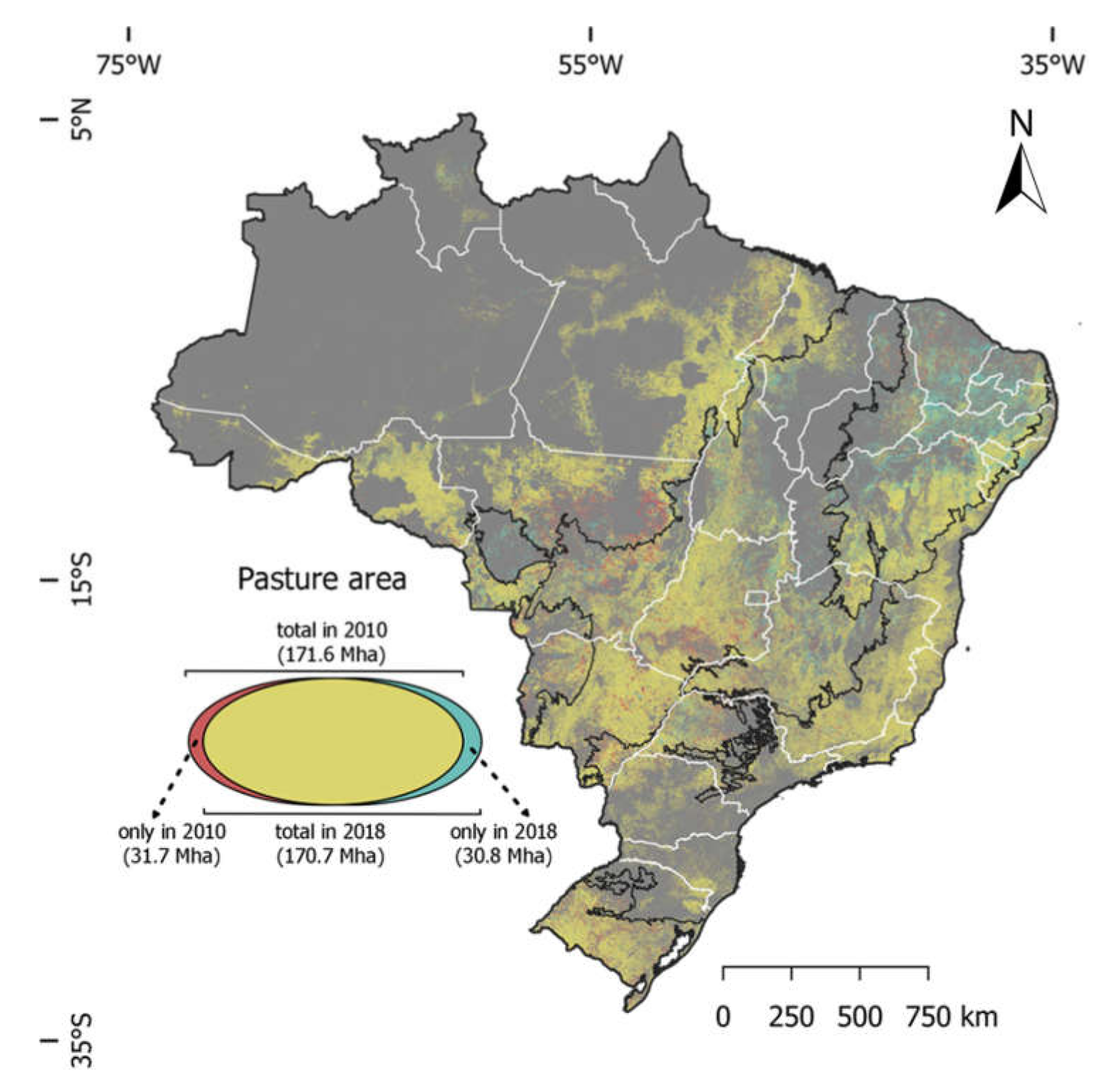
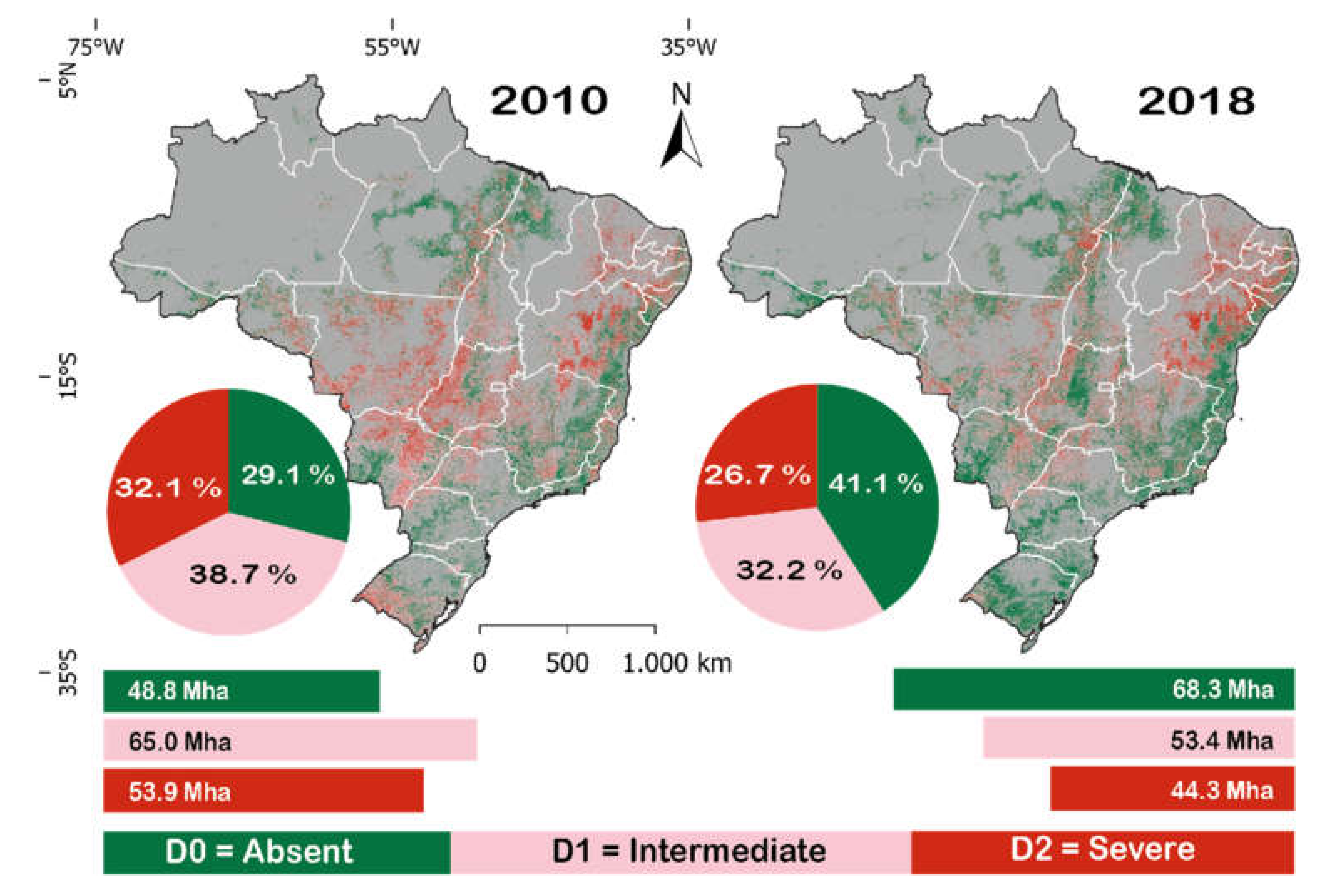
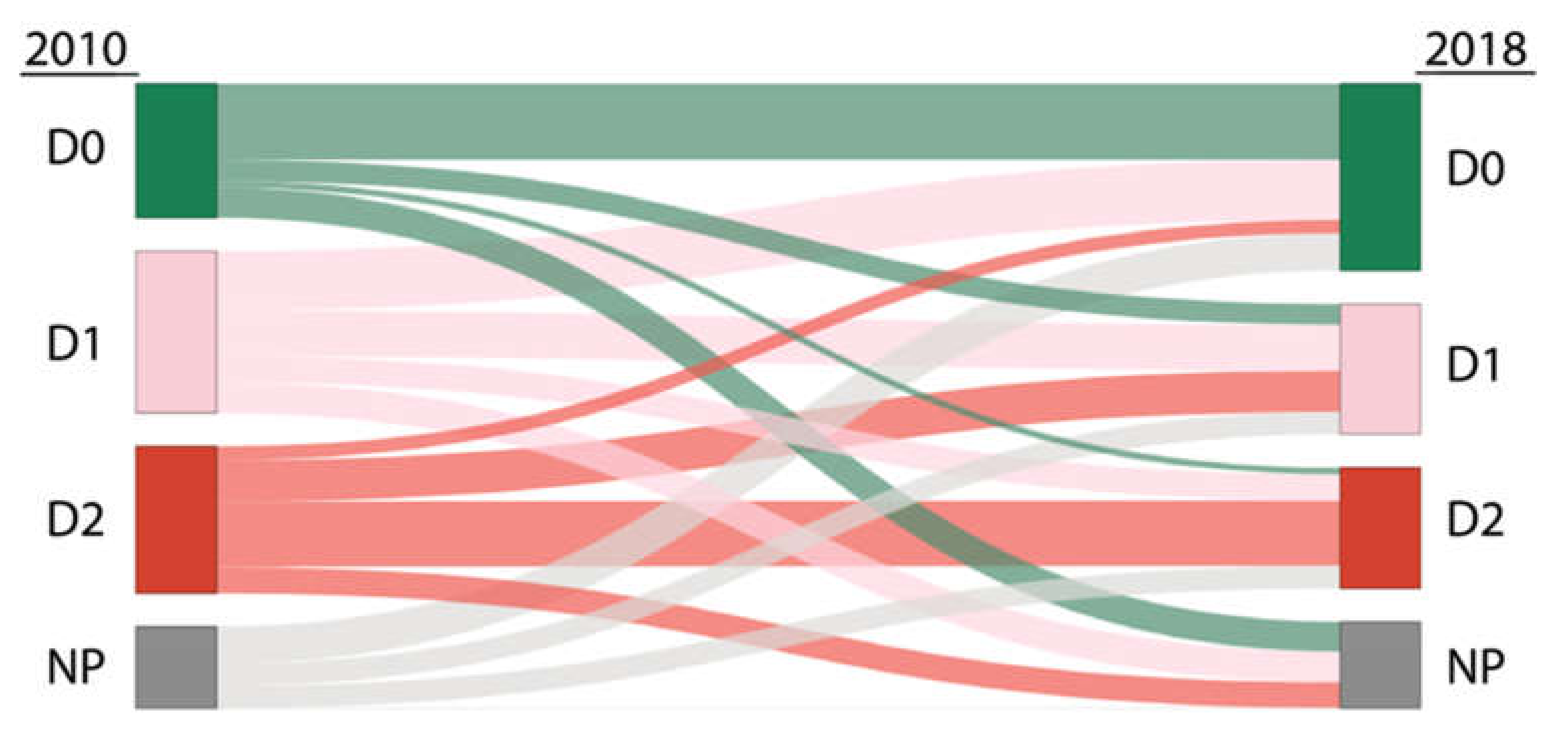
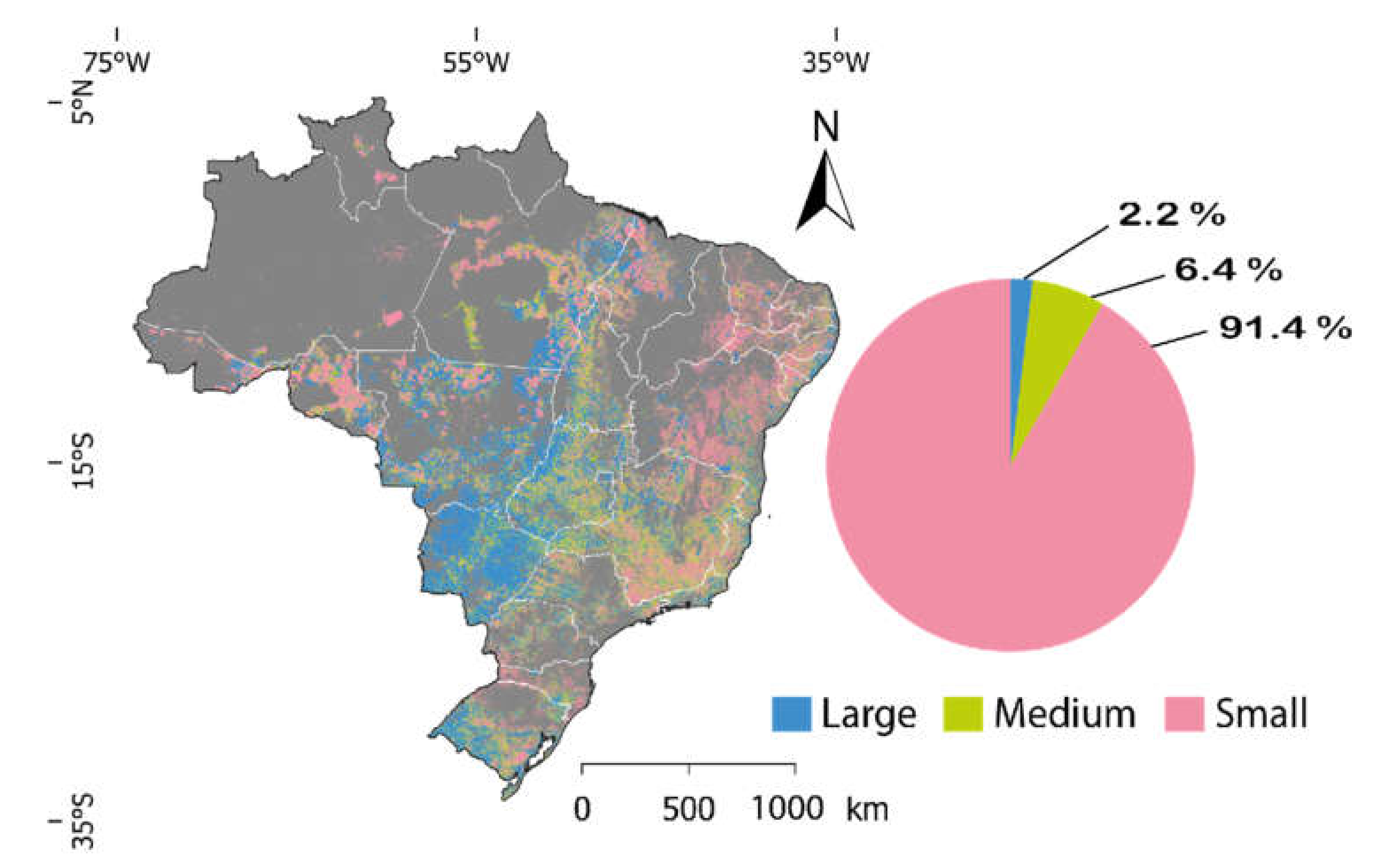
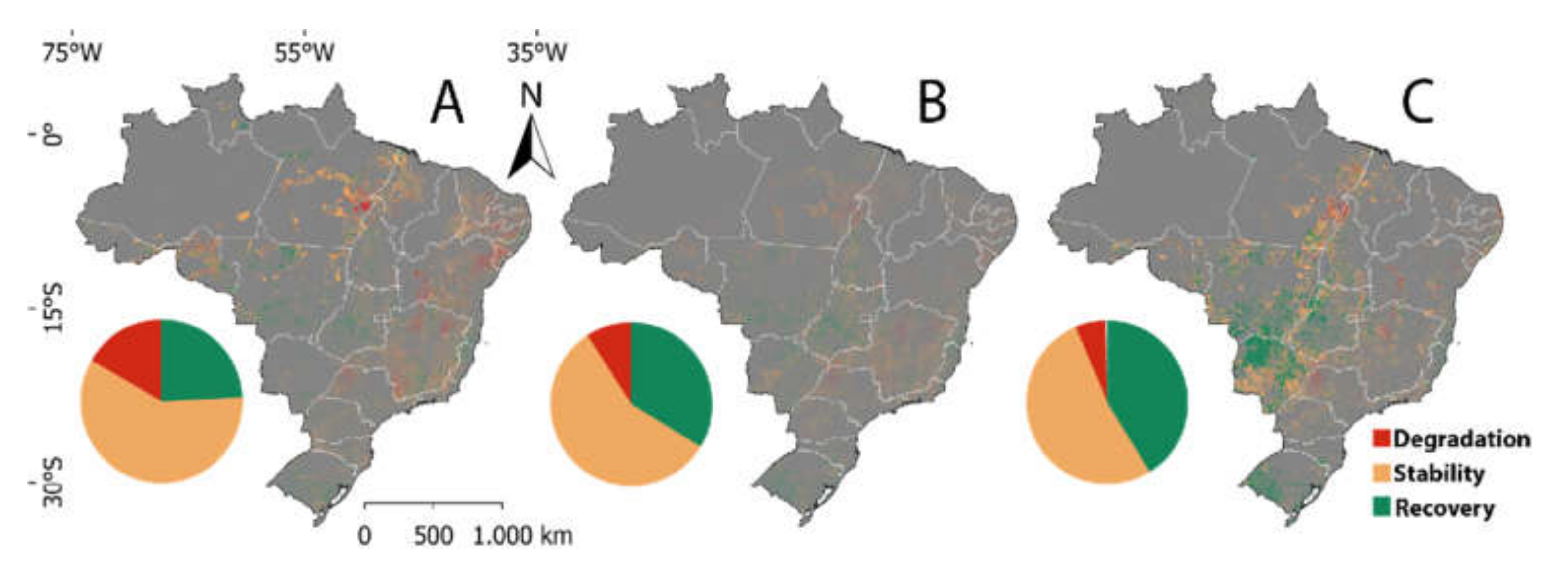
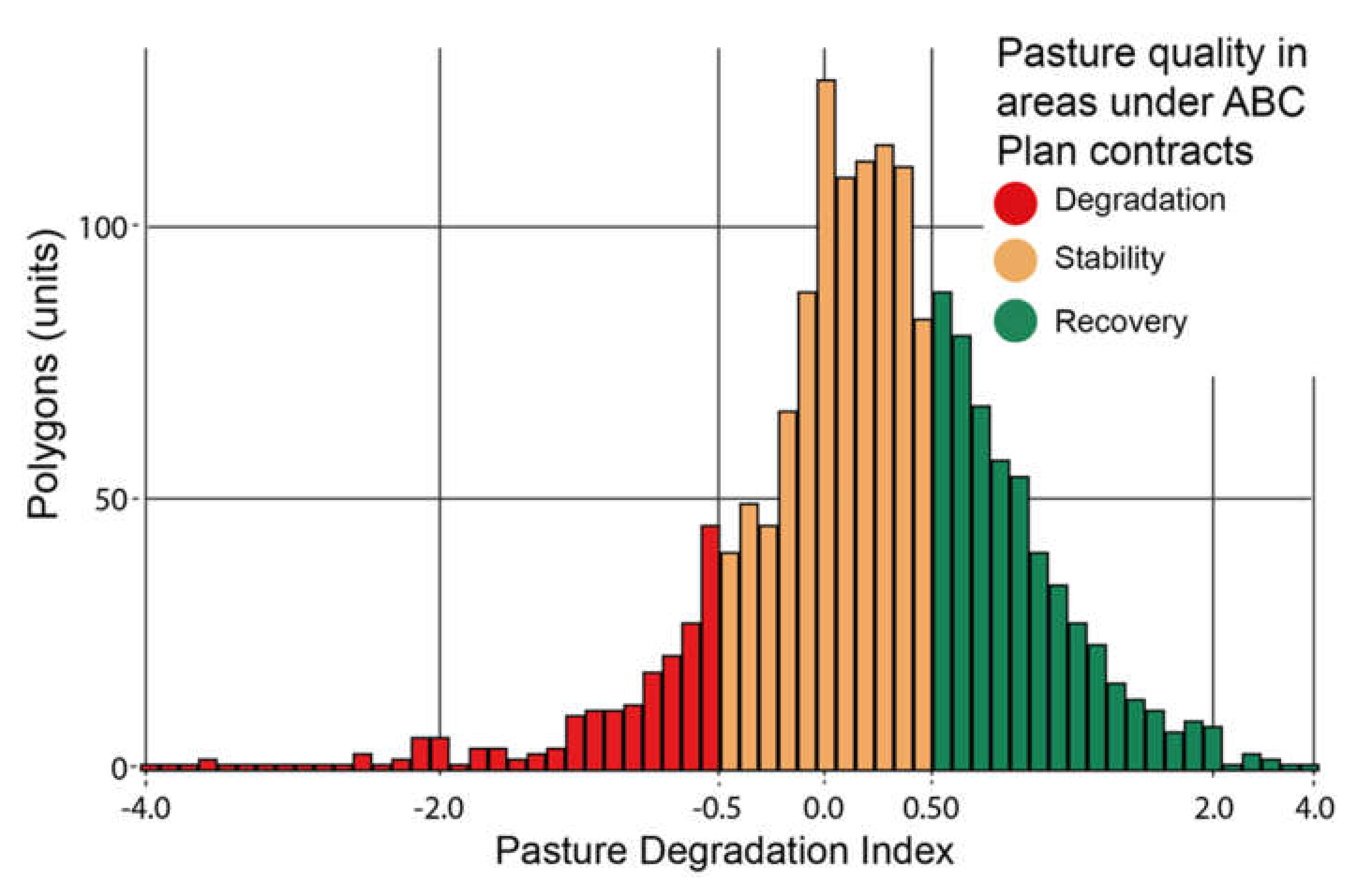
| Absent | Intermediate | Severe | UA 2 | |
|---|---|---|---|---|
| Absent | 13 | 8 | 1 | 59% |
| Intermediate | 4 | 11 | 1 | 69% |
| Severe | 3 | 5 | 7 | 47% |
| PA 1 | 65% | 46% | 78% |
| Quality | Number of Rural Properties | |||
|---|---|---|---|---|
| Small | Medium | Large | Total | |
| Stable | 1,451,311 (59.2%) | 97,200 (57.3%) | 31,589 (52.7%) | 1,580,100 (58.9%) |
| Increase | 595,445 (24.3%) | 57,452 (33.9%) | 24,696 (41.2%) | 677,593 (25.3%) |
| Reduction | 406,192 (16.6%) | 15,027 (8.9%) | 3711 (6.2%) | 424,930 (15.8%) |
| Total | 2,452,948(100%) | 169,679(100%) | 59,996(100%) | 2,682,623(100%) |
Publisher’s Note: MDPI stays neutral with regard to jurisdictional claims in published maps and institutional affiliations. |
© 2022 by the authors. Licensee MDPI, Basel, Switzerland. This article is an open access article distributed under the terms and conditions of the Creative Commons Attribution (CC BY) license (https://creativecommons.org/licenses/by/4.0/).
Share and Cite
Santos, C.O.d.; Mesquita, V.V.; Parente, L.L.; Pinto, A.d.S.; Ferreira, L.G., Jr. Assessing the Wall-to-Wall Spatial and Qualitative Dynamics of the Brazilian Pasturelands 2010–2018, Based on the Analysis of the Landsat Data Archive. Remote Sens. 2022, 14, 1024. https://doi.org/10.3390/rs14041024
Santos COd, Mesquita VV, Parente LL, Pinto AdS, Ferreira LG Jr. Assessing the Wall-to-Wall Spatial and Qualitative Dynamics of the Brazilian Pasturelands 2010–2018, Based on the Analysis of the Landsat Data Archive. Remote Sensing. 2022; 14(4):1024. https://doi.org/10.3390/rs14041024
Chicago/Turabian StyleSantos, Claudinei Oliveira dos, Vinícius Vieira Mesquita, Leandro Leal Parente, Alexandre de Siqueira Pinto, and Laerte Guimaraes Ferreira, Jr. 2022. "Assessing the Wall-to-Wall Spatial and Qualitative Dynamics of the Brazilian Pasturelands 2010–2018, Based on the Analysis of the Landsat Data Archive" Remote Sensing 14, no. 4: 1024. https://doi.org/10.3390/rs14041024
APA StyleSantos, C. O. d., Mesquita, V. V., Parente, L. L., Pinto, A. d. S., & Ferreira, L. G., Jr. (2022). Assessing the Wall-to-Wall Spatial and Qualitative Dynamics of the Brazilian Pasturelands 2010–2018, Based on the Analysis of the Landsat Data Archive. Remote Sensing, 14(4), 1024. https://doi.org/10.3390/rs14041024









